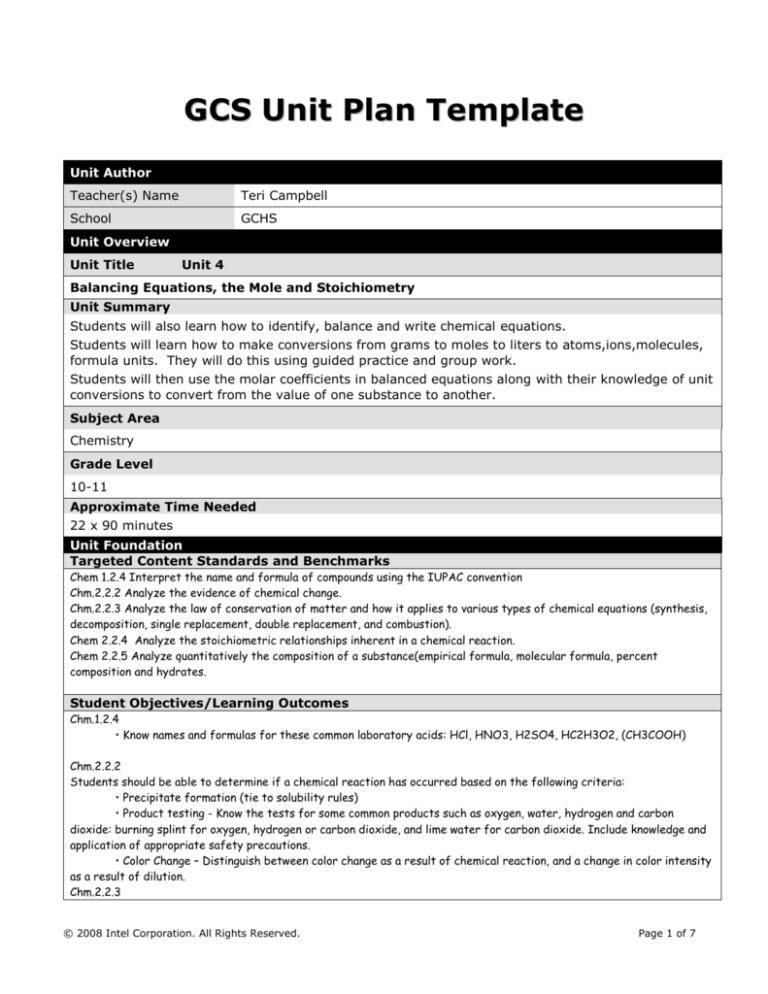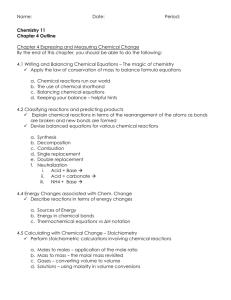
GCS Unit Plan Template
Unit Author
Teacher(s) Name
Teri Campbell
School
GCHS
Unit Overview
Unit Title
Unit 4
Balancing Equations, the Mole and Stoichiometry
Unit Summary
Students will also learn how to identify, balance and write chemical equations.
Students will learn how to make conversions from grams to moles to liters to atoms,ions,molecules,
formula units. They will do this using guided practice and group work.
Students will then use the molar coefficients in balanced equations along with their knowledge of unit
conversions to convert from the value of one substance to another.
Subject Area
Chemistry
Grade Level
10-11
Approximate Time Needed
22 x 90 minutes
Unit Foundation
Targeted Content Standards and Benchmarks
Chem 1.2.4 Interpret the name and formula of compounds using the IUPAC convention
Chm.2.2.2 Analyze the evidence of chemical change.
Chm.2.2.3 Analyze the law of conservation of matter and how it applies to various types of chemical equations (synthesis,
decomposition, single replacement, double replacement, and combustion).
Chem 2.2.4 Analyze the stoichiometric relationships inherent in a chemical reaction.
Chem 2.2.5 Analyze quantitatively the composition of a substance(empirical formula, molecular formula, percent
composition and hydrates.
Student Objectives/Learning Outcomes
Chm.1.2.4
• Know names and formulas for these common laboratory acids: HCl, HNO3, H2SO4, HC2H3O2, (CH3COOH)
Chm.2.2.2
Students should be able to determine if a chemical reaction has occurred based on the following criteria:
• Precipitate formation (tie to solubility rules)
• Product testing - Know the tests for some common products such as oxygen, water, hydrogen and carbon
dioxide: burning splint for oxygen, hydrogen or carbon dioxide, and lime water for carbon dioxide. Include knowledge and
application of appropriate safety precautions.
• Color Change – Distinguish between color change as a result of chemical reaction, and a change in color intensity
as a result of dilution.
Chm.2.2.3
© 2008 Intel Corporation. All Rights Reserved.
Page 1 of 7
• Write and balance chemical equations predicting product(s) in a reaction using the reference tables.
Chm.2.2.4
• Interpret coefficients of a balanced equation as mole ratios.
• Use mole ratios from the balanced equation to calculate the quantity of one substance in a reaction given the
quantity of another substance in the reaction. (given moles, particles, mass, or volume and ending with moles, particles,
mass, or volume of the desired substance)
Chm.2.2.5
• Calculate empirical formula from mass or percent using experimental data.
• Calculate molecular formula from empirical formula using molecular weight.
• Determine percentage composition by mass of a given compound.
• Perform calculations based on percent composition.
• Determine the composition of hydrates using experimental data.
Cross-Curricular Connections
Math – equations
English – writing lab papers
Curriculum-Framing Questions
Essential
Question
Unit
Questions
Content
Questions
Why do you think it is important for industrial chemists to understand how to use
stoichiometry in their professions?
What is a situation when you or your parent/guardian have used the concept of
“limiting reactants” in daily life?
How did Avogadro determine that 1 mol of any substance = to 6.02 x 10 23?
How does the law of conservation of mass, matter and energy govern all
aspects of chemistry?
What is a mole and why is it used in Chemistry?
What is stoichiometry?
Assessment Plan
Unit Details
Prerequisite Skills
Basic Math Skills and dimensional Analysis
Instructional Procedures
Day 1
1- Review writing the formulas for ionic and covalent compounds
2- Introduce students to the acids they need to know the name and formula for.
3- Categorizing Chemical Equations as single or double replacement, synthesis, decomposition, combustion
4- Learn how to use the packet to help i.d. equations
Day 2
1- Review a few homework problems and collect homework
2- Begin writing and balancing equations
3- Group work activity
Homework - worksheet on balancing equations
Days 3 & 4
© 2008 Intel Corporation. All Rights Reserved.
Page 2 of 7
1- Review balancing equations homework
2- Continue working problems writing and balancing equations
3- Predicting products or reactants in an incomplete chemical equation.
Homework – study guide
Day 5
Test on formula/name writing and writing and balancing chemical equations
Day 6
1- introduction to the mole
2- calculating molar mass of an element or compound
3- learning how to make conversions using the conversion factor...
1 mol = molar mass = 22.4 L = Avogadro's number
Homework - worksheet with conversions
Day 7
Continue practicing conversions
Quiz on conversions
Day 8
Calculating % composition
Practice problem worksheet
Day 9
Quiz on % composition
Calculating empirical formula
Practice problems
Day 10
Review empirical formula
Quiz on empirical formula
Calculating molecular formula
Day 11
Review molecular formula
Study guide group work
Day 12
Test on The Mole
Day 13
Lab Single Replacement Reaction
Lab Empirical Formula Lab
Day 14
Stoichiometry
Mole->Mole and Vol->Vol conversions
Day 15
Review one step problems
Quiz
Vol <->Mol and Mass<->Vol
© 2008 Intel Corporation. All Rights Reserved.
Page 3 of 7
Day 16
Review 2 step pblms
Quiz
Mass<->Vol and Mass<->Mass
Day 17
Review 3 step pblms
Conversions involving Avogadro’s Number
Day 18
Review all Stoichiometry pblms
Honors Limiting Reactants
Day 19
Quest on Stoichiometry
Review for unit test
Day 20
Unit test
Day 21
Limiting reactants lab
Accommodations for Differentiated Instruction
Special Needs
Students
Concentrated tutoring in small groups with the teacher and student
leaders,
Complete limiting reactant problems
Gifted/Talented
Students
Materials and Resources Required For Unit
Technology – Hardware (Click boxes of all equipment needed)
X Interactive Technology
Computer(s)/iPads, etc.
Digital Camera
X DVD Player
X Internet
Student Response
System/Clickers
Printer
X Projection System
Scanner
Cell Phone
Video Camera
Video Conferencing Equip.
Document Camera
Other
X Television
Technology – Software (Click boxes of all software needed.)
© 2008 Intel Corporation. All Rights Reserved.
Page 4 of 7
Database/Spreadsheet
Image Processing
Web Page Development
Desktop Publishing
Internet Web Browser
Word Processing
E-mail
Multimedia
Other
X Web-Based Encyclopedia
Textbook Merrill and Prentice Hall and worksheets associated with each
Printed Materials
Teacher made worksheets
Current Science
Copper, iron filings, copper (II) sulfate, aluminum other basic lab equipment
Supplies
Page 5 of 7
Additional Unit Plan Information
Internet and Additional Resources
List additional resources for the lesson/unit plan or related lesson plans that map to the Common Core Standards in
the lesson/unit plan.
Common Core Standard
Resource
http://www.glenoaks.edu/facultystaff/FacultyWebSites/SarahSimmons/Documents/NSC130%20Stoichiometry%20Worksheet.pdf
http://dsc.discovery.com/tv-shows/mythbusters/videos/savage-stoichiometry.htm
http://www.teachertube.com/viewVideo.php?video_id=159573
http://funtchemistry.blogspot.com/2013/03/stoichiometry-winter-2013.html
Page 6 of 7
Unit Plan Reflection
Describe any adaptations or “tweaks” to the resource or lesson plan that were needed:
What do you plan to do differently the next time you teach this unit?:
This unit took two additional days because students required me move a slower pace. The honors students,
with the addition of limiting reactant and percent yield equations, also required extended time. The change will
be reflected in next semester’s unit plans.
I will also add https://www.khanacademy.org/science/mcat/physical-processes/stoichiometry/v/stoichiometry
as a website resource.
Page 7 of 7







